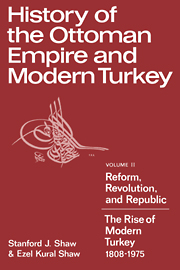Book contents
- Frontmatter
- Contents
- List of Tables
- Preface
- Preface to the second printing
- List of Abbreviations
- Note on Pronunciation
- Map of the Growth of the Ottoman Empire, 1280–1683
- Map of the Decline of the Ottoman Empire, 1683–1975
- 1 The Beginnings of Modern Ottoman Reform: The Era of Mahmut II, 1808–1839
- 2 The Era of Modern Reform: The Tanzimat, 1839–1876
- 3 Culmination of the Tanzimat: The Reign of Abdulhamit II, 1876–1909
- 4 The Young Turk Period, 1908–1918
- 5 The Turkish War for Independence, 1918–1923
- 6 The Turkish Republic, 1923–1975
- Appendix
- Bibliography: History of the Ottoman Empire and Modern Turkey, 1808–1975
- Index
3 - Culmination of the Tanzimat: The Reign of Abdulhamit II, 1876–1909
Published online by Cambridge University Press: 20 May 2010
- Frontmatter
- Contents
- List of Tables
- Preface
- Preface to the second printing
- List of Abbreviations
- Note on Pronunciation
- Map of the Growth of the Ottoman Empire, 1280–1683
- Map of the Decline of the Ottoman Empire, 1683–1975
- 1 The Beginnings of Modern Ottoman Reform: The Era of Mahmut II, 1808–1839
- 2 The Era of Modern Reform: The Tanzimat, 1839–1876
- 3 Culmination of the Tanzimat: The Reign of Abdulhamit II, 1876–1909
- 4 The Young Turk Period, 1908–1918
- 5 The Turkish War for Independence, 1918–1923
- 6 The Turkish Republic, 1923–1975
- Appendix
- Bibliography: History of the Ottoman Empire and Modern Turkey, 1808–1975
- Index
Summary
Abdulhamit II came to the throne at the youthful age of 34, having been born to one of Abdulmecit's concubines, Tirimüjgân Kadin, soon after his father's accession, on September 21, 1842. During his years as prince, he seems to have distinguished himself among his brothers by avoiding the new style European frivolity that was entering the palace under his father's influence, avoiding extravagance to the point of parsimony. He also spent a great deal of time outside his apartments in the Dolmabahçe Palace at a summer house on the Bosporus above Tarabya, a small pleasure palace at Kâgithane, on the Golden Horn, at his mother's house in Maçka, in the country outside Beyoğlu, and in the palace of his sister, using the opportunity to contact Ottomans of all ranks and some foreigners, discussing with them the problems of the empire and how they could be resolved. Particularly close to him in these early days were an Englishman named Thompson, who owned a farm next to his at Tarabya, and two lesser Tanzimat bureaucrats, Ibrahim Ethem Efendi and Mehmet Esat Saffet Efendi, most famous of the nineteenth-century ministers of education, both of whom subsequently served him for a time as grand vezirs. His personal finances were handled by a well-known Armenian Galata banker, Hagop Zarifi Bey, from whom he gained a knowledge of finance and economics that was to serve him well in later times. The young prince was thus a sincere though somewhat dour and persistent young man who was determined to prepare himself as best he could for the task of rescuing the empire.
- Type
- Chapter
- Information
- History of the Ottoman Empire and Modern Turkey , pp. 172 - 272Publisher: Cambridge University PressPrint publication year: 1977



